|
28th October
Ardmore Point
With clear blue skies predicted in the West of Scotland, we headed for
Ardmore Point, west of Dumbarton. We hadn’t visited there since May so we were looking forward to trekking around the small peninsula.
The day started on a poor note though as at Dumbarton Morrisons
John’s breakfast was very slow in making an appearance (7/10).
Undeterred we pressed on to the Point where we found conditions were
idyllic, all we needed were the delights of nature to turn up. We set
off and straight away we noted that the South Bay was very quiet.
We had to walk a few hundred meters before I got our first captures.
Most wild flowers had died back as autumn progressed into winter, but by
the side of the path, almost hidden in the long grass, a lonely Yarrow
wildflower was still in bloom. Lining the fence, stretches of
Blackberries were ripening. None of the berries had actually turned
black though, and whether or not they do would surely depend on
escaping the ravages of winter frost. A bit further on I snapped a
Prickly Sow Thistle, another late flower. The first bird we encountered
was 50m beyond the flowers, a Herring Gull floating against the light
near the shore. Then another 50m on, we startled a flock of Canada Geese
that had been grazing in a field. They rather obligingly flew over our
heads, providing me with a great photo-opportunity (see “Pictures
of the Week”, below)
| Yarrow |
Prickly - sow Thistle |
Herring Gull |
Canada Goose |
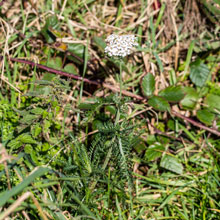 |
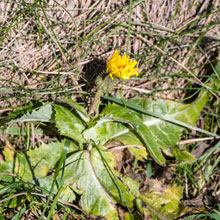 |
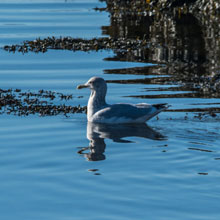 |
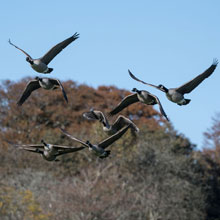 |
The low sun lit a wee Chaffinch
sitting in a bush by the shore. It flew off fairly quickly but drew my
eyes to a silhouetted Cormorant drying its wings. We were about halfway
round and the sightings were disappointingly sparse. In the distance
was the beautiful sight of Helensburgh nestling near the mouth of the
Gareloch (which leads to Faslane ), with ochre-coloured hills in the background. The only birds we could now see were a large flock of Eider at
least 400m offshore towards Greenock on the south side of the Estuary.
We heard them before we saw them, their “hu-whooo,
hu-whooo” calls being very distinctive.
| Chaffinch |
Cormorant |
Helensburgh |
Eider |
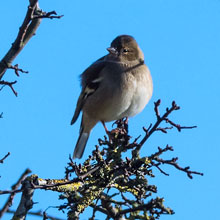 |
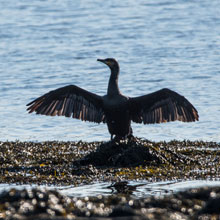 |
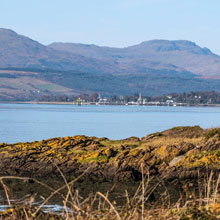 |
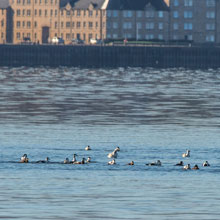 |
The path then passed through a
large patch of Gorse, most of which was over 6 ft high. We immediately
came upon a feisty Robin, that was almost silhouetted by the sunlight.
There was some sort of stand-off going on between it and another Robin
some 20m away, as it seemed to ignore us for a bit before flying off
towards the interloper. The Gorse was now producing seeds, with only a
few yellow flowers evident. We also saw a large shrub with red berries
and dark green waxy leaves (yet to be identified). As we approached the
North Bay we were hoping for better luck with the birds as we had
walked a long way without seeing very much. Another Herring Gull,
better lit, floated close in and looking at us rather impassively,
before flying off after another Gull.
| Robin |
Gorse |
Berries? |
Herring Gull |
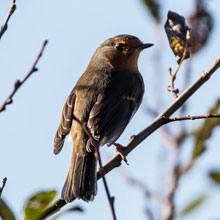 |
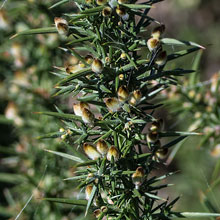 |
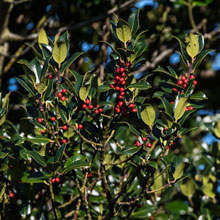 |
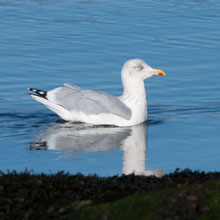 |
John spotted a Great Crested Grebe
too far out for a decent picture and, closer in, a Shag that was
arduously working the water. I’ve got to admit we find difficulty at
times distinguishing Shags from Cormorants. I think everyone does though. As we walked along edge of the North Bay, the story was the same, very few birds. It wasn’t until we
reached where the path cuts back across fields to the car park that
things started to heat up. The remaining pictures below were all taken
within the final 30 minutes of our journey. First of these was of the
familiar Oystercatcher, nicely reflected in the waters of the advancing
tide. Next a lippy lady walker scolded us (jokingly) for resting low on
our stools and missing a Curlew lurking close by in the salt marsh.
| Shag |
Oystercatcher |
Redshank |
Curlew |
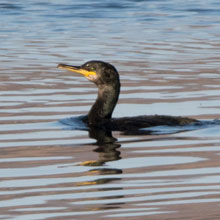 |
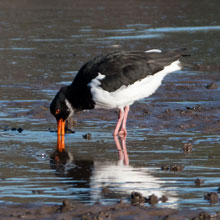 |
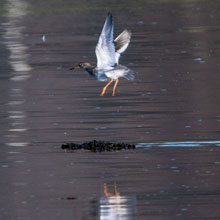 |
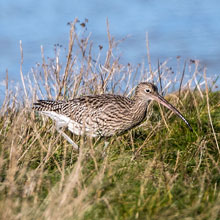 |
We were about to traverse the fields, past some grazing Clydesdales , when a pair of young scopers directed us to the east end of the bay where they had seen a Little Egret .
“That’ll do me”, I thought and proceeded cautiously
along the edge of the bay and found a suitable point to sit and observe
the birds in that area. It was fairly busy (at last!). Curlews and Teal
were coming and going. We found the Little Egret, but it was distant at
the most easterly point and had edged out of view on the south shore.
| Clydesdale Horse |
Curlew |
Female Teal |
Little Egret |
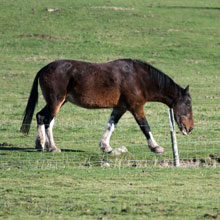 |
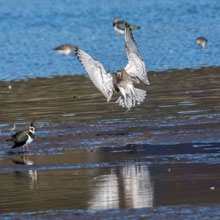 |
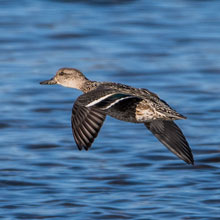 |
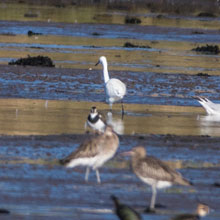 |
We crept a bit closer to the area
where the Egret was and managed to find a natural hide behind a slightly
raised bank. From there we intended to wait for the reappearance of the
Egret. As we waited though, I managed shots of a passing Carrion Crow,
Shelduck, Dunlin and Teal, male and female (see “Pictures of the
Week”, below). The icing on the cake, suppose, were pictures of
close fly pasts of Lapwings bathed in the now orange-tinted light of the
descending sun. These birds were probably migrants from the west of the
European continent.
| Carrion Crow |
Shelduck |
Dunlin |
Drake Teal |
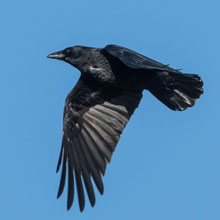 |
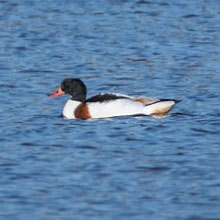 |
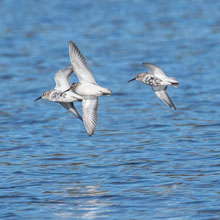 |
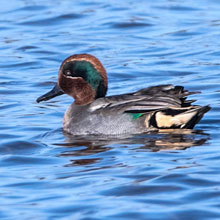 |
As we were approaching the end of
our walk. We were genuinely considering how we could get enough for a
blog this week. We should’ve known better. It is not uncommon to
get the majority of one’s photos in one short spell, especially
if circumstances concentrate all of the possible sightings in a small
area, such as just happened when the high tide pushed the birds to the
east of the Bay. So “all’s we’ll that ends
well” - and, at risk of gilding the lily, we rounded it off with
tea and Danish Pastry sitting under blue sky, warm sun and no wind - as
usual, not to detract from the day’s successes, it was the best
bit!
Pictures of the Week:
| Blackberry |
Canada Goose |
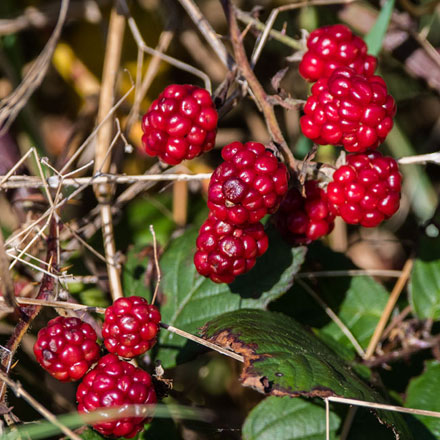 |
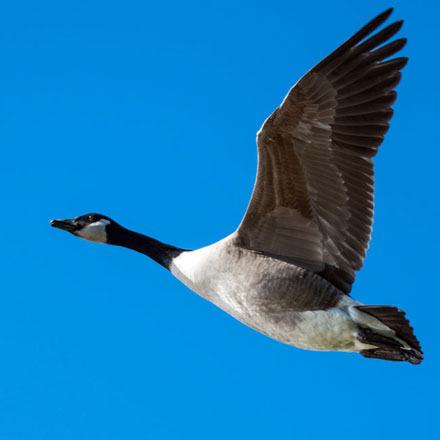 |
| Teal |
Lapwing |
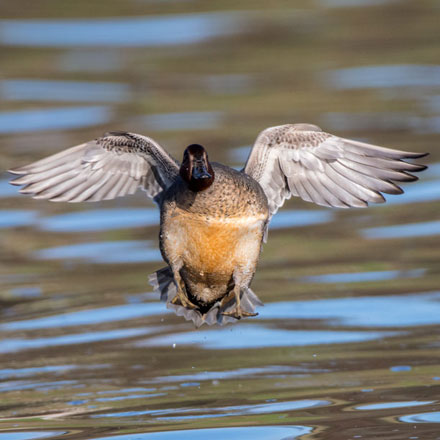 |
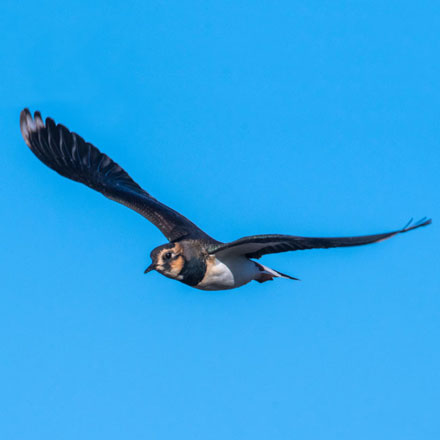 |
21st October 2018:
Troon Harbour, Pow Burn
We had great weather for last
week’s outing but I kinda knew it wouldn’t last. My weather
app was telling me the whole of Central Scotland was to be wet, wet,
wet - at least until mid-afternoon. We headed west as the poor weather
seemed to be clearing there first. I fancied Troon as the car park
overlooks the sea and shore so we’d be able to watch, and
photograph from the shelter of the car. We called in at the Kilmarnock
ASDA cafe for our customary breakfasts, which were ok, but not great
7/10 (cold beans and bacon and a drippy teapot).
Troon Harbour:
When we arrived at Troon it was
“fair drookit”, as we say (very wet) in Scotland. As we sat
in the car scanning the damp panorama, John spotted the “Roman
nose” snout of a Grey Seal bobbing in the sea, about 30m
out. We saw a few more after that. Eventually the rain went off
after about a half hour, dry enough for a stroll along the sparsely
populated shore. Just the odd Herring Gull and Oystercatcher braved the
conditions. A flock of Greenfinches was skirting the high harbour wall
from which they tentatively risked dropping to the sand below to feed.
Most of the dozen or so birds were juveniles. A pair of Eiders bolted
past, north into the harbour. As we were just leaving the shore, I saw
a wee Rock Pipit hopping along the rocks by the wall (see “Pictures of the Week”, below).
| Grey Seal |
Herring Gull |
Greenfinch |
Eider |
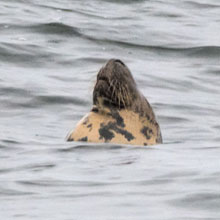 |
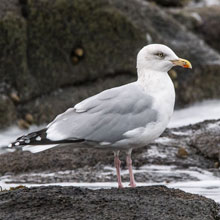 |
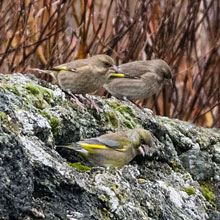 |
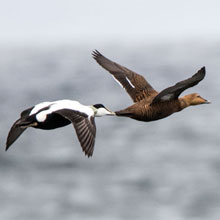 |
A pair of lost-looking
Black-headed Gulls stood motionless on the rocks, as we moved slowly
toward the north end of the wall, where we could see Shags were
perching, occasionally one would launch itself out over the waves,
others were returning onto the wall to dry out and digest their food.
We put up a small flock of Ringed Plover that had been camouflaged in the
shingle. I think they surprised us as much as we surprised them. I
managed a nice shot of a passing Oystercatcher just as the rain
returned. We quickly headed back in to car, picking up a snap of a
still-flowering Scentless Mayweed, which, in Scandinavia, is called Baldr’s Brow.
| Black - headed Gull |
Shag |
Oystercatcher |
Scentless Mayweed |
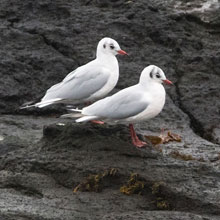 |
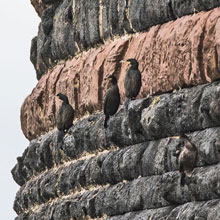 |
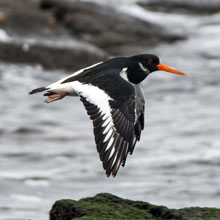 |
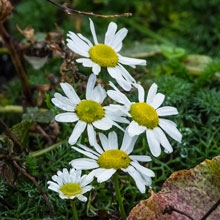 |
Pow Burn:
We decided to cut our losses and move
a short drive south, where it looked brighter, to Pow Burn near
Prestwick. When we arrived, it was dull but dry and just by the car
there was a striking patch of Broom laden with black seed pods. On our
short route towards the Burn we came across several flowers of interest,
including Knapweed, Michaelmas Daisy and Creeping Thistle. In the UK,
the latter is considered to be an “injurious weed”, but the
Bruichladdich distillery on Islay lists Creeping Thistle as one of the sources of the ingredients of its gin.
| Broom |
Common Knapweed |
Michaelmas Daisy |
Creeping Thistle |
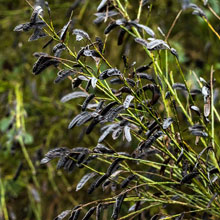 |
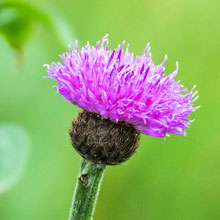 |
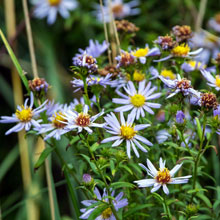 |
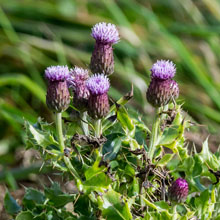 |
The surface of the bridge over the
Pow Burn was covered with a 1cm deep puddle of water. We picked our way
across and noticed several Mallards on the Burn, getting quite excited
about something. A Redshanks was making its way along the water’s
edge picking out invertebrates as it went. As we walked around the high
ground that follows the route of the Burn, I spotted a wee Dunnock
sitting in a bush. Across the burn, in the long grass, a couple of male
Pheasants caught my eye. As you might have noticed its picture below,
the sun was now shining (also see “Pictures of the Week”,
below). John saw a third Pheasant in the same area.
| Mallard |
Redshank |
Dunnock |
Pheasant |
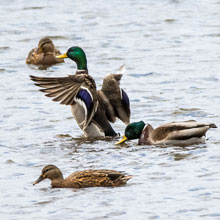 |
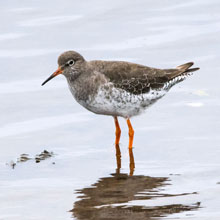 |
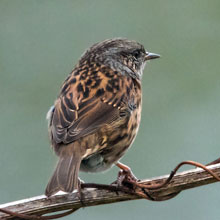 |
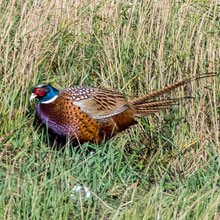 |
On the short grass of a practice area for golfers of the Prestwick Golf Club, we came across three fungi: Clustered Brittlestem , Shaggy Inkcap and Stunted Cavalier.
Just as I’d finished gathering fungi pictures, a handsome drake
Mallard passed overhead. I have always thought that Mallards are very
underrated, perhaps because there are so many of them.
| Clustered Brittlestem |
Shaggy Inkcap |
Stunted Cavalier |
Mallard |
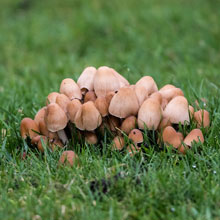 |
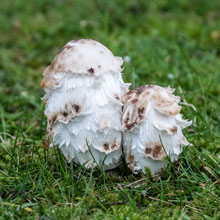 |
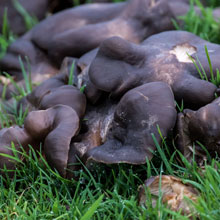 |
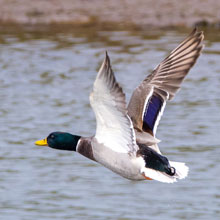 |
On
the Pow Burn, a pair of juvenile Wigeon were lapping up the sunshine.
The bird nearest to the camera had a dark green shading over and behind
its eyes. At the time, this reminded me of the markings of the drake American Wigeon ,
but I’ve since come to believe it was a male juvenile Eurasian
Wigeon. Just as we had been discussing how quiet Prestwick airport had
been, a huge, roaring, Canadian military aircraft took off and put up
most of the Wigeon and Oystercatchers that had been on the Burn.
Interestingly, the Redshanks weren’t spooked. Neither was a
Little Grebe as it continued with its dives for little fish.
| Juvenile Wigeon |
Globemaster III |
Wigeon |
Little Grebe |
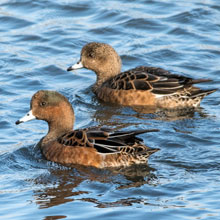 |
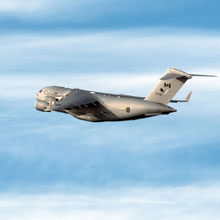 |
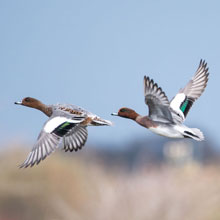 |
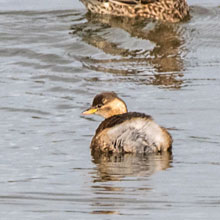 |
After
the plane had gone, the Burn looked rather more vacant, as it now only
held only a few Teal and, standing on the muddy banks with the
Redshanks, I saw a pair of Greenshanks .
More grey-coloured, and with light green legs, they hardly moved the
whole time we were there. At the mouth of the Burn we saw a family of
Mute Swans. I think that was the first time over many years, we’d
seen Swans there. On our trek back to the car, I was keeping an eye,
and both ears, open for Stonechats.
I wasn’t disappointed as one turned up on the tall grass of the
beach dunes. The light was behind it, however, but Photoshop helped a
bit with lightening the picture. My final shot of the day was of a
rain-soaked Large Bindweed (see “Pictures of the Week”, below).
| Teal |
Greenshank |
Mute Swan |
Stonechat |
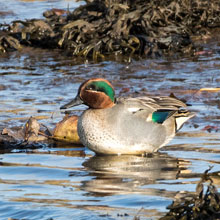 |
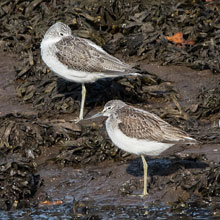 |
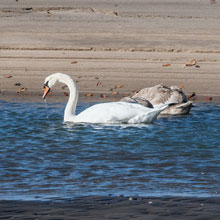 |
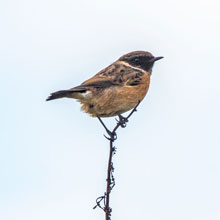 |
Our trip had started slowly in
gloomy weather, but as the day progressed, and the weather improved, it
fairly livened up and, at the car, a crescendo was reached, as John
produced some of his home baking - sultana and apple strudel, which
went down a treat with strong tea. By the end we had accumulated enough
sightings for two blogs. We hope you’ve enjoyed the selection
we’ve published here.
Pictures of the Week:
| Rock Pipit |
Pow Burn |
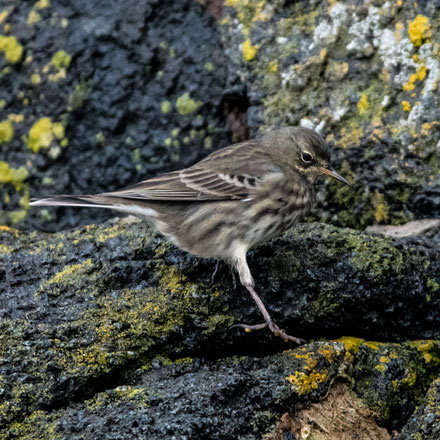 |
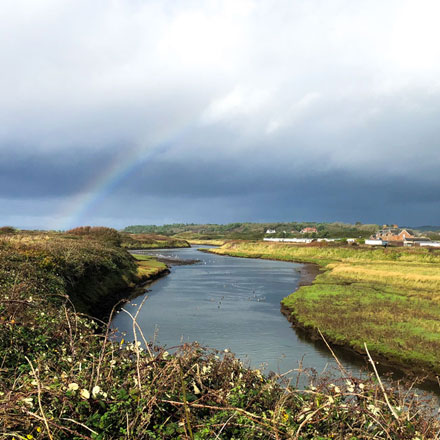 |
| Wigeon |
Large Bindweed |
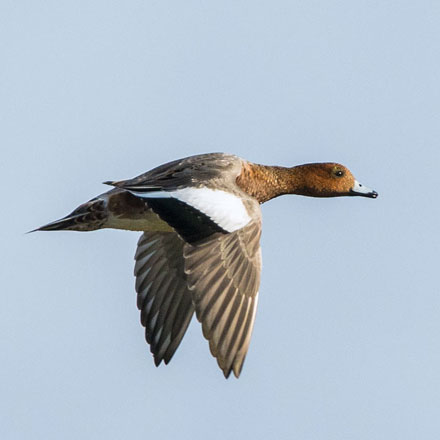 |
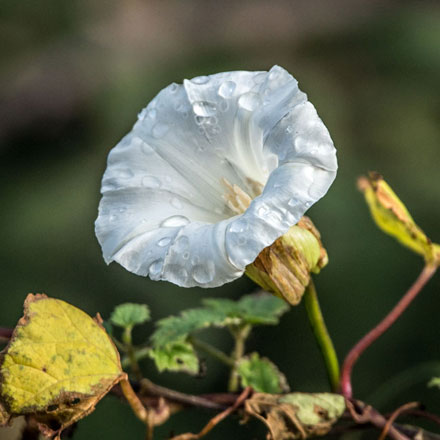 |
14th October 2018:
Stevenston, Saltcoats, Irvine Harbour
For the first time in a few weeks,
bright, dry weather was predicted for the West of Scotland, so we
decided to visit our favourite trio of sites on the North Ayrshire
coast - Stevenson, Saltcoats and Irvine Harbour. But first we stopped off
at Stevenston Morrisons cafe and enjoyed a pair of excellent
breakfasts:10/10 - highly recommended if you’re ever in the area.
As we drove onto Stevenston Point,
the sun hadn’t quite broken through but I did notice a Skylark
scurrying in the grass. I managed to stop and snap it from my
driver’s seat. The tide was low and several Cormorants were on
the rocks drying their wings. One in particular drew our interest as
its back was pure black, in contrast to the rest of its plumage which
was a rather dark, metallic, copper-colour. Perhaps it was immature.
Next, three large Mute Swans took to the air, no doubt encouraged by
the usual Sunday dog walkers looming nearby. As they passed I could see
the sunlight wasn’t too far away as across the Firth of Clyde
lovely Arran was now illuminated.
The
first sunbeams of sunlight uncovered a Grey Heron lurking in the rocks
to the left of the Cormorants. It was the first time we had seen one
there. The birds seemed to be livened by the brightness. A handsome
Redshank picked its way through shallow pools below us, and a pair of
Eider sped past south. I picked up a fairly large flock of Sanderlings
flying in the opposite direction before coming to rest on the beach
amongst some Gulls on a sandy spit. For once we were willing the dog
walkers to disturb them so that they might fly back to the Point. It
didn’t happen.
| Grey Heron |
Redshank |
Eider |
Sanderling |
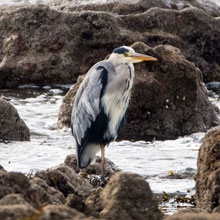 |
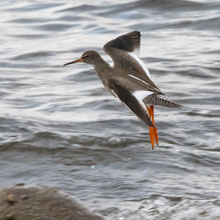 |
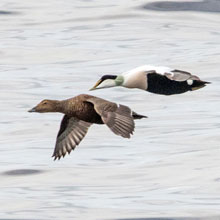 |
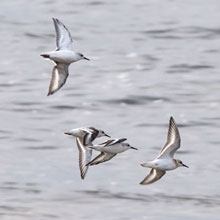 |
On
the south side of the Point I managed a couple of pictures of Pipits.
The first was of a Meadow Pipit, with its light, creamier look. On the
rocks, I captured a shot of the more drab Rock Pipit. Next, I was
attracted by the familiar cheeps of a Grey Wagtail (surely a more apt
name would be the Yellow-rumped Wagtail). I traced its calls to
shoreline rocks. Our final capture on the Point was of a pair of Mute
Swans (probably the ones we’d seen earlier) that were beautifully
silhouetted by the now strong sunlight behind them.
| Meadow Pipit |
Rock Pipit |
Grey Wagtail |
Mute Swan |
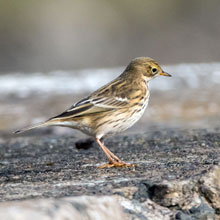 |
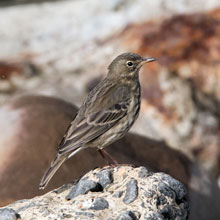 |
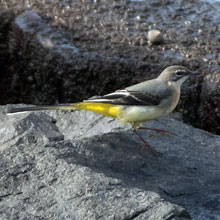 |
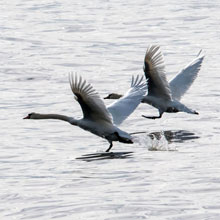 |
Just
up the coast from Stevenston we parked the car at Saltcoats Harbour and
immediately came across a Curlew foraging close in on the rocks. It
seemed to be used to people passing as it was unconcerned by our
attention. A Feral Pigeon was a bit more wary, keeping its eyes on me
until I was out of sight. No such worries for the “gallus”
Herring Gull. I was at the close limit of my camera lens and it
couldn’t have cared less. But most skittish were the Starlings.
They were up and away at the mere flick of a wrist.
| Curlew |
Feral Pigeon |
Herring Gull |
Starling |
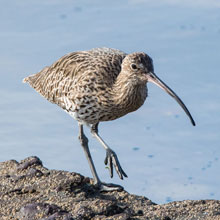 |
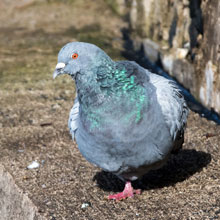 |
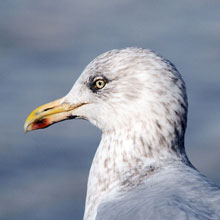 |
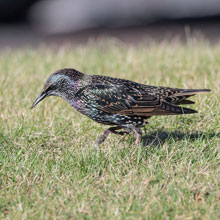 |
Walking
along the north side of the harbour we could see (against the sunlight)
many birds making the most of the low tide feeding opportunities before
the tide came in. Oystercatchers were perhaps the most noticeable, and
noisiest, as they searched the rock pools. A large group of Ringed
Plovers were joined by a single Sanderling. A single Black-headed Gull
stood motionless in the midst of the
activity as if it had already had its fill. Most of the Redshanks
present were roosting in a group but one was climbing over large rocks
searching for titbits.
| Oystercatcher |
Sanderling |
Black - headed Gull |
Redshank |
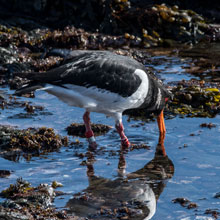 |
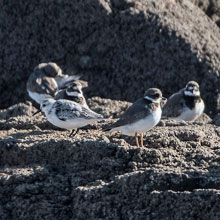 |
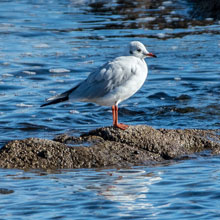 |
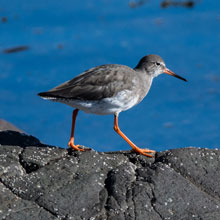 |
I was
a bit disappointed not to have seen Purple Sandpipers on the rocks of
Saltcoats Harbour, and there were no Terns or Gannets. Although very
pleasant, it all seemed a bit quiet. We drove to Irvine Harbour for a
short visit and as we stepped out of the car we just missed out on a
picture of a Seal close to the walkway. There seemed to very little
else on the river. The closest birds we could see, some Lapwings, were
about 200m away. It was with some delight then when a Cormorant flew
past us up the river. Then I noticed, just across the Irvine, a Great
Black-backed Gull. We decided to take a stroll up to the river mouth. A
noisy Black-headed Gull passed us at just above head height. Most
likely it was checking us out for bread.
| Lapwing |
Cormorant |
Great Black - backed Gull |
Black - headed Gull |
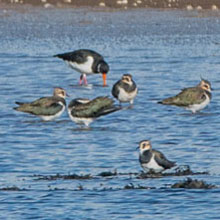 |
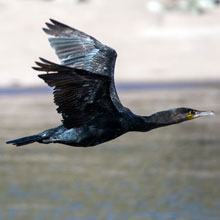 |
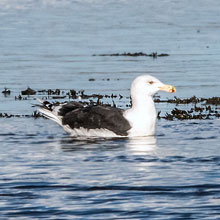 |
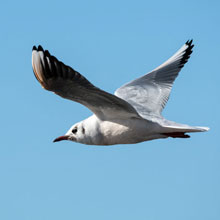 |
All we saw on our walk were a pair
of Rooks on a tower of security cameras (see “Pictures of the
Week”, below). As we returned to the car I caught an
Oystercatcher bolting downstream over a magnificent preening Mute Swan.
John pointed out that well beyond them (~200m), three Seals were
sitting on a platform over away on the Garnock. My camera managed an
image good enough to distinguish the Seals. I think the right and
centre Seals have “doggy-like” heads and are Common Seals
and the left, from its “Roman nose”, is a Grey Seal . Our
last picture of the visit was of a flock of Feral Pigeons that circled
the car park just as we were settling down on our stools, preparing tea.
| Oystercatcher |
Mute Swan |
Common / Grey Seals |
Feral Pigeon |
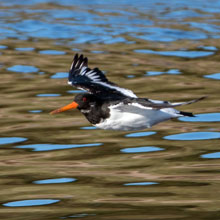 |
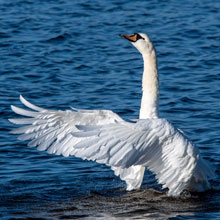 |
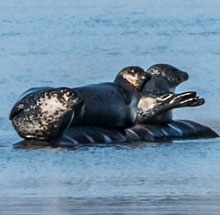 |
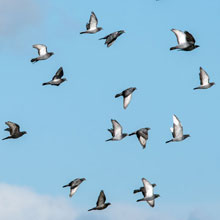 |
It
had been an enjoyable trip with a few highlights such as the
Sanderlings and Seals, and a few pleasing photographs had been taken
(see below). Definite highlights were the cream-filled fruited scones
from Morrisons which, with lovely strong tea, drew the expedition to a
very satisfactory conclusion. And of course the blue skies had helped
to make it one of those outings made us feel that it was a pity we had
to go home.
Pictures of the Week:
| Meadow Pipit |
Starling |
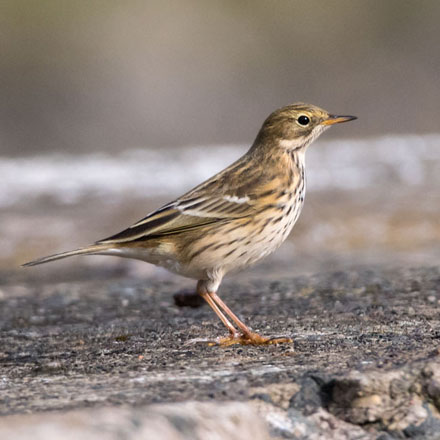 |
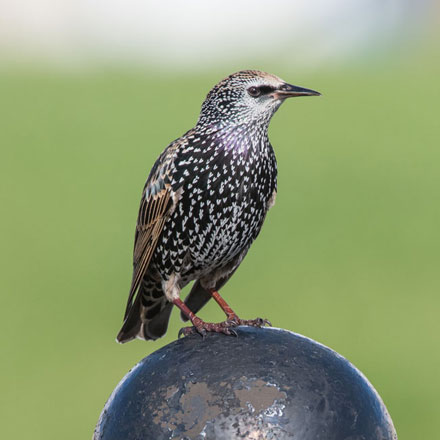 |
| Rooks. Ralph and Roger!! |
Feral Pigeon |
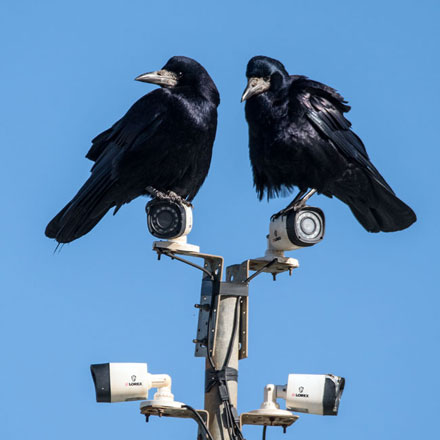 |
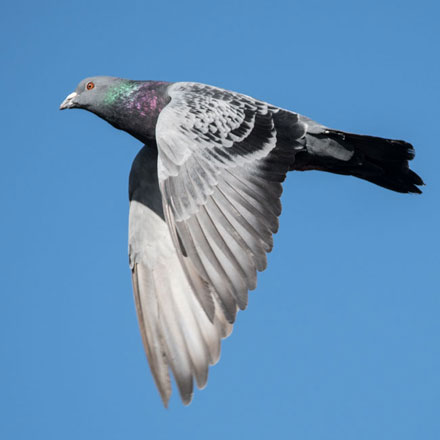 |
7th October 2018:
Musselburgh
With an approaching weather front moving in from the
Atlantic set to drench Central Scotland, we travelled east to Dalkeith
Morrisons for breakfast. As we dined (9/10), the weather seemed to be darkening
and it had started to spitting with rain. We decided to cut our losses and opt
for Musselburgh, rather than travelling further east where the
weather may have been just as bad. In the recent weeks, I had visited
Musselburgh searching for even a record shot of the White-winged Scoter but I had always arrived
after it had left. “Maybe this time”, I said to John. We parked on the approach road into Levenhall Links and
walked down to the sea wall just to the east of the Scrapes. The first bird we
saw was a Cormorant perched on top a yellow sewage outlet. Not surprisingly, a good place to find birds. “There’s Sammy!”, roared John, our code for
“There’s a Seal”, in this case, a Common Seal. It was fairly close to the the
wall, but the light was poor. Next, an adult Gannet swept past without diving.
About 150m offshore we spotted a small flock of Velvet Scoter. I scanned the flock
to determine if one of them was the White-winged Scoter - sadly not.
| Cormorant |
Common Seal |
Gannet |
Velvet Scoter |
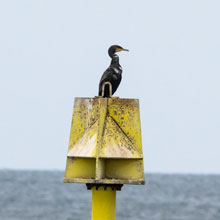 |
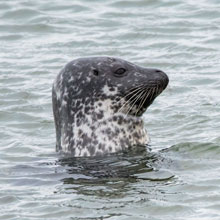 |
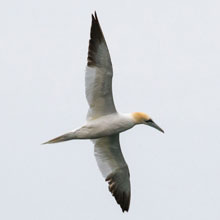 |
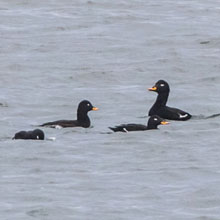 |
The tide was reaching its high point and birds were pouring
on to the Scrapes. They were mainly Oystercatchers, Redshanks and Bar-tailed
Godwits. We decided to visit the Scrapes as there were blue skies to the West,
so we guessed the light would improve. On our way there we were passed by a
couple of Juvenile Gannets and far out on the sea I noticed a pair of winter
plumage Slavonian Grebes . In breeding plumage these are the most attractive
of the UK’s grebes, and although their winter plumage is not as fetching, I
think their red eyes certainly catch one’s attention.
| Oystercatcher |
Bar - tailed Godwit |
Juvenile Gannet |
Slavonian Grebe |
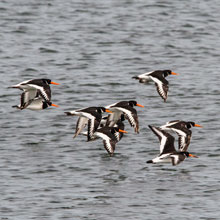 |
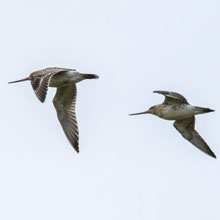 |
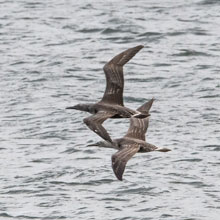 |
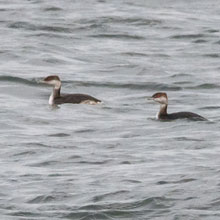 |
From the hides we could see many birds. A group of a dozen
Redshanks were roosting in the centre of the Middle Scrape. John estimated that
there were over 1000 Oystercatchers crowding the central area of the Reserve. I
could also see significant numbers of Curlew and also a pair of Shelduck.
| Redshank |
Oystercatcher |
Curlew |
Shelduck |
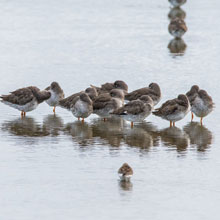 |
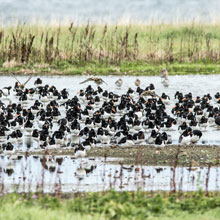 |
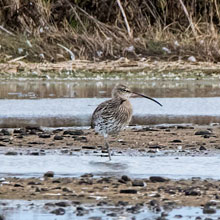 |
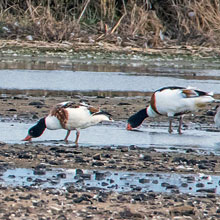 |
Suddenly, something seemed to put up a lot of the birds and
I noticed that there were Golden Plovers
among them. In Scotland, they winter mainly on the coast, but in summer they
move to upland moorlands. About half a
dozen Dunlin had been feeding near to the Redshanks, but they were also
disturbed. Not so the Teal, who dabble contentedly throughout. Gradually all of
the birds settled and order was restored. Bar-tailed Godwits had landed at the
back of one of the Scrapes but took a while to feel safe enough to tuck their
beaks beneath their wings.
| Golden Plover |
Dunlin |
Teal |
Bar - tailed Godwit |
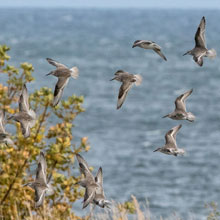 |
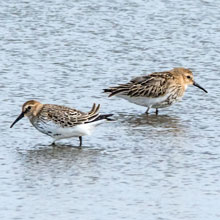 |
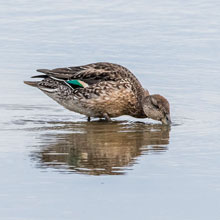 |
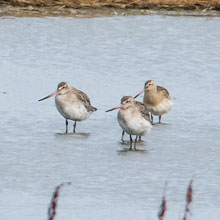 |
On leaving the Scrapes we were greeted by about 100 noisy
Greylags flying overhead. They approached from the direction of the Esk. Some of
them settled in the Scrapes but most circled back from whence they came. We
were returning to the car, intending to view the sea from Fisherrow to check
that the White-winged Scoter hadn’t been hiding there. A Guillemot popped up
just below the sea wall probably attracted in by Mackerel shoals. A juvenile
Shag bobbed up and down on the waves as it watched us pass by. Just as I was
snapping it, a handsome Cormorant flew past. I wondered if it was one of the
continental “sinensis” race, but I’m uncertain.
| Greylag Goose |
Common Guillemot |
Shag |
Cormorant |
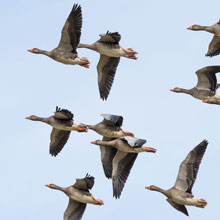 |
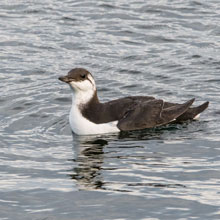 |
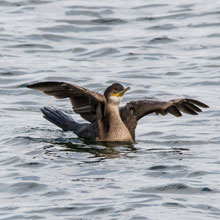 |
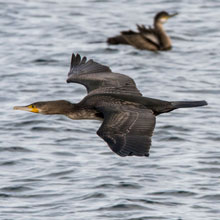 |
Just as we were about to move away from the sea wall, a
Scoter flew across our view, but once again it was a Velvet, not the species we
were after. By the path, on the way back to the car I noticed that there were
still wild flowers in bloom. Scentless Mayweed, Yarrow and Common Ragwort a plant with a bad reputation.
| Velvet Scoter |
Scentless Mayweed |
Yarrow |
Common Ragwort |
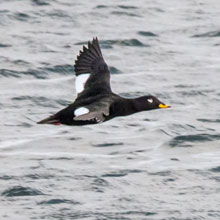 |
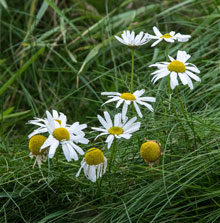 |
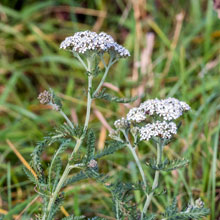 |
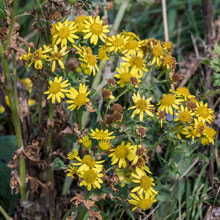 |
I drove along to Fisherrow but we didn’t see any Scoters
there, only several boats that might have unsettled them. Undeterred, we
travelled back to the mouth of the Esk. We could see poor weather moving in
from the west, but were delighted to see a pair of Red-breasted Mergansers fly
upstream. A young Herring Gull was continually lifting something from the sea
and dropping it. At first I thought it was a Razorshell
but from the pictures I could see it was a shard of wood. Maybe it too
thought it was a Razorshell. John spotted flocks of Wigeon gathered 50m out in the ever
more choppy sea. Occasionally some of them flew further into the mouth of the
river. We decided we too should get into a more sheltered place - the car for a
tea and pastry!
| Red - breasted Merganser |
Herring Gull |
Eider |
Wigeon |
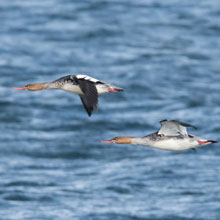 |
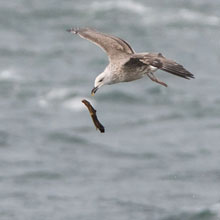 |
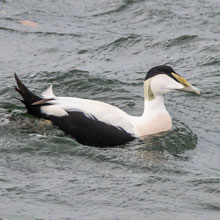 |
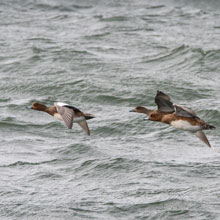 |
We normally have our tea, by the car, sitting on our stools.
However, the wind and rain forced us inside the car, but given the weather
prediction, we were pleased the rain held off so long - we even had a period of
brightness. From these pictures you can see that our species count was fairly
high (25) given the relatively short time we were there. However I’ve finished
business with the White-winged Scoter!
| Teal |
Kestrel |
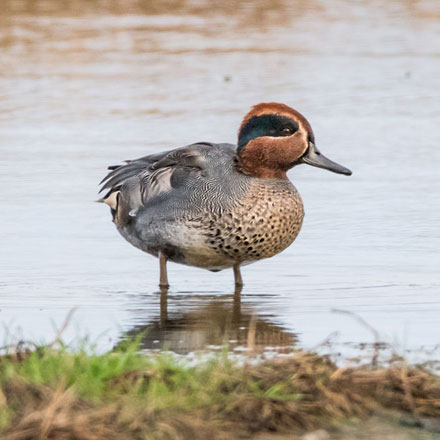 |
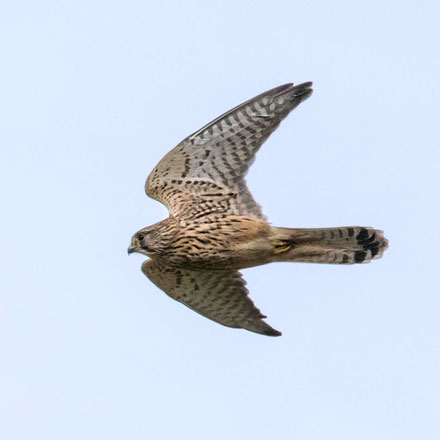 |
| Greylag |
Common Guillemot |
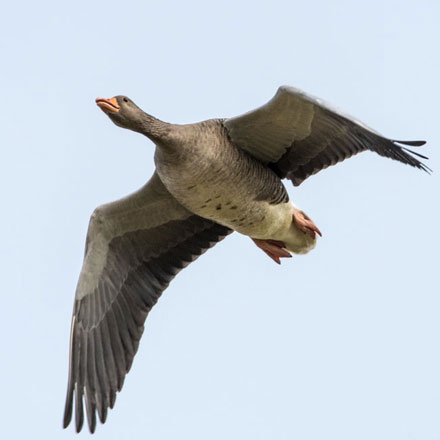 |
 |
Back To Top
|

